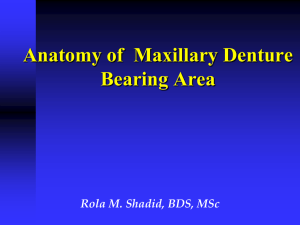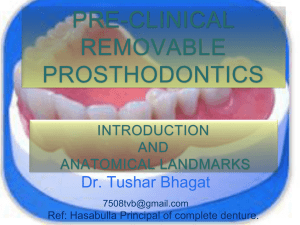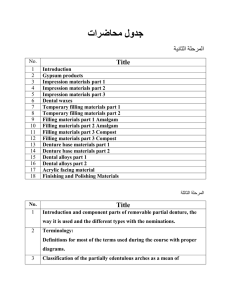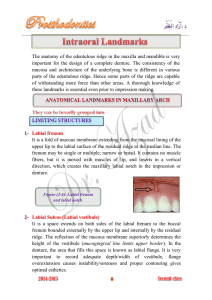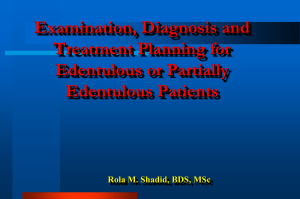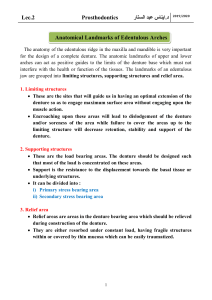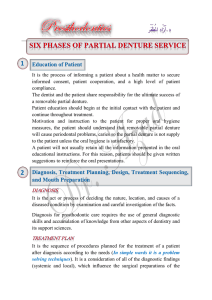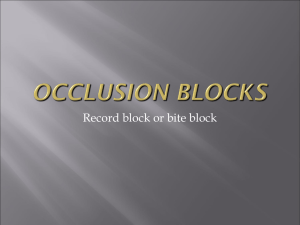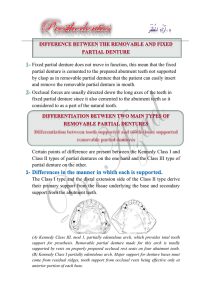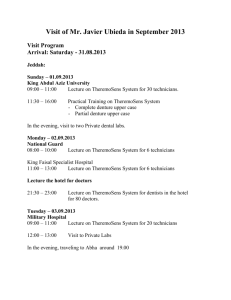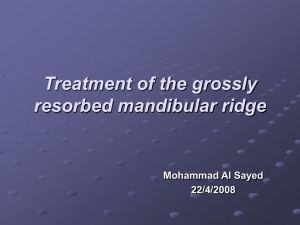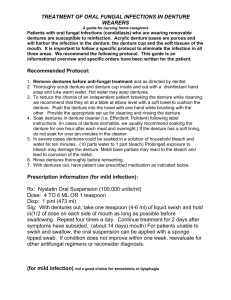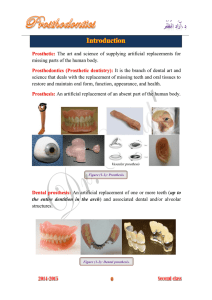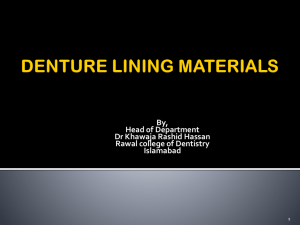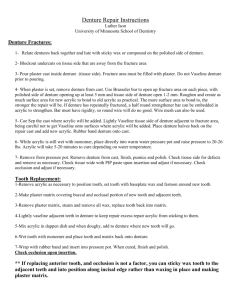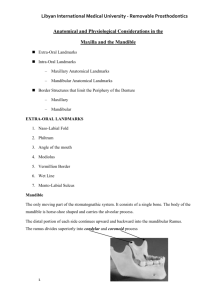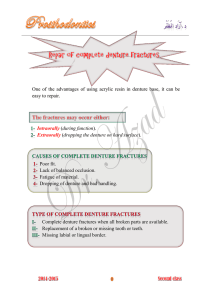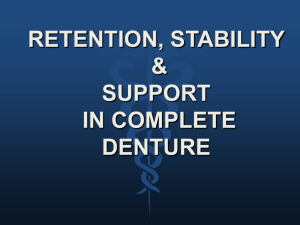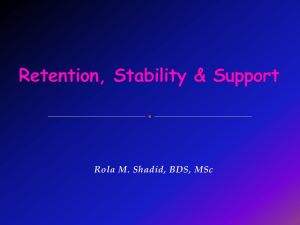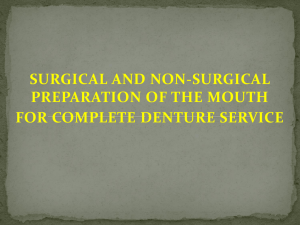A. Choose the BEST answer from the following questions: Torus
advertisement
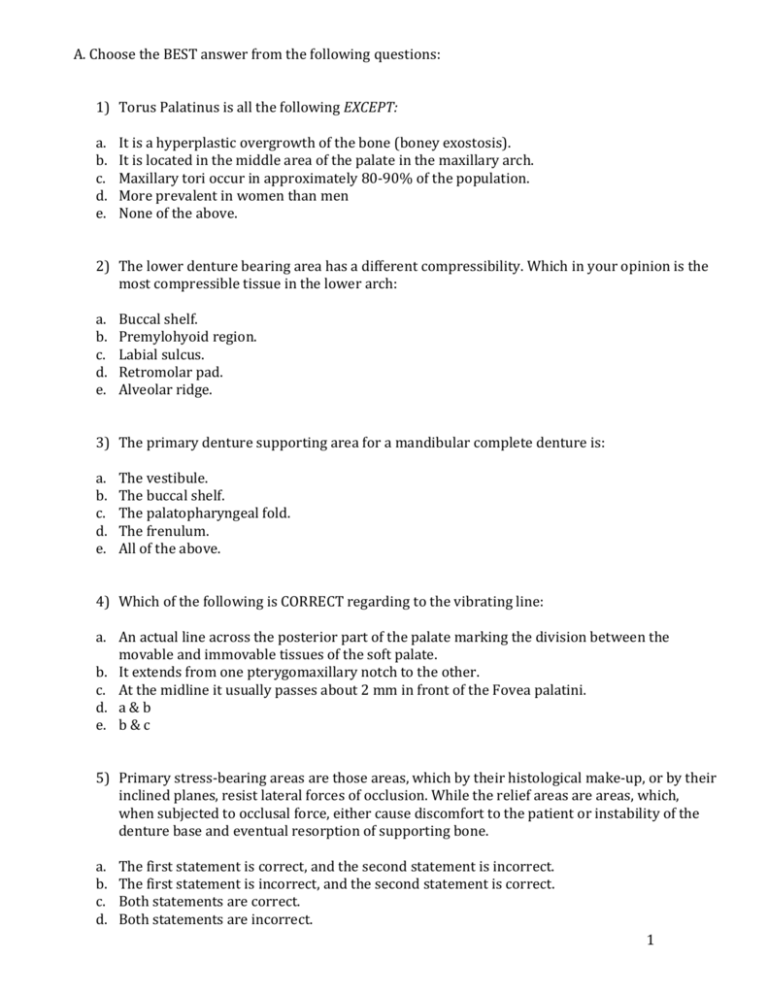
A. Choose the BEST answer from the following questions: 1) Torus Palatinus is all the following EXCEPT: a. b. c. d. e. It is a hyperplastic overgrowth of the bone (boney exostosis). It is located in the middle area of the palate in the maxillary arch. Maxillary tori occur in approximately 80-90% of the population. More prevalent in women than men None of the above. 2) The lower denture bearing area has a different compressibility. Which in your opinion is the most compressible tissue in the lower arch: a. b. c. d. e. Buccal shelf. Premylohyoid region. Labial sulcus. Retromolar pad. Alveolar ridge. 3) The primary denture supporting area for a mandibular complete denture is: a. b. c. d. e. The vestibule. The buccal shelf. The palatopharyngeal fold. The frenulum. All of the above. 4) Which of the following is CORRECT regarding to the vibrating line: a. An actual line across the posterior part of the palate marking the division between the movable and immovable tissues of the soft palate. b. It extends from one pterygomaxillary notch to the other. c. At the midline it usually passes about 2 mm in front of the Fovea palatini. d. a & b e. b & c 5) Primary stress-bearing areas are those areas, which by their histological make-up, or by their inclined planes, resist lateral forces of occlusion. While the relief areas are areas, which, when subjected to occlusal force, either cause discomfort to the patient or instability of the denture base and eventual resorption of supporting bone. a. b. c. d. The first statement is correct, and the second statement is incorrect. The first statement is incorrect, and the second statement is correct. Both statements are correct. Both statements are incorrect. 1 6) All of these are considered as a relief areas EXCEPT: a. b. c. d. e. Incisive papilla. Torus palatinus. Zygomatic process. Lateral slopes of the palate. Median palatal raphe. 7) Which of the following is considered as a RESISTANT border seal areas: a. b. c. d. e. Labial frenum. Buccal frenum. Ptergomandibular raphe. Distobuccal arch. All of the above. 8) The mylohyoid ridge or line is an irregular rough boney crest on the external surface of the mandible that extends inferiorly from the mental spines near the inferior border of the mandible anteriorly to just below the third molar area posteriorly. a. True b. False 9) Regarding to the palatal vault form, which of the following is CORRECT: a. A flat palate resists lateral shifts well, but vertical displacement tends to break the seal. b. V-shaped palate has good vertical support but provides no resistance to lateral shifts. c. Curved (U-shaped) palate provides the most favorable prognosis and resists well both vertical and lateral displacement. d. All of the above. e. None of the above. 10) Prosthesis: a. It is the art and science of supplying artificial replacements for missing parts of the human body, b. An artificial replacement of an absent part of the human body. c. The branch of dentistry pertaining to the restoration and maintenance of oral function, comfort, appearance and health of the patient by the restoration of natural teeth and/or the replacement of missing teeth and craniofacial tissues with artificial substitutes. d. None of the above. 2 11) Resorption: a. b. c. d. 12) a. b. c. d. Continuous throughout the life. After the extraction. Most marked in the period of healing and remodeling of bone following extraction. All of the above. Denture retention: It is the resistance to vertical movement of the denture base toward the ridge. It is the resistance to horizontal or rotational forces. It is the resistance to displacement of the denture base away from the ridge. a& b. 13) Cohesion it is the force of attraction existing between dissimilar bodies in close contact. a. True b. False 14) The polished surface of the lower denture faces outward and upward on the lingual surface. a. True b. False 15) Thick saliva will provides greater retention to the denture more than thin saliva. a. True b. False B. Fill in the space provided below by the appropriate words: 16) The. ……………………………………….. muscle pulls the buccal frenum forward, while the ……………………………… muscle pulls it backward. 17) Physical factors affecting denture retention: 1. 2. 3. 4. …………………………………………… …………………………………………… …………………………………………… …………………………………………… 3
